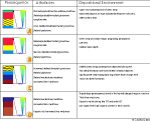 |
|
|
|||
|
Correlation using Parasequences; parasequence sets; and systems tracts As demonstrated by the exercises that follow, the interpretation of carbonates can be enhanced by first identifying the parasequences, or cycles (Pomar, 1991; and Pomar and Ward, 1994, 1995, 1999), in cores and well logs that penetrate the section being studied. Van Wagoner et al., (1990) were among the first to recognize that parasequences boundaries can be easily correlated regionally, and coincidently represent good time markers. Van Wagoner et al., (1990) also reasoned that carbonate parasequences were deposited when the rate of accumulation exceeded the rate at which accommodation space developed; they argued that a parasequence boundary (mfs) formed when the rate at which accommodation space was created exceeded the rate of sediment supply ("give-up") and there is termination of the carbonate factory. The difference in the character of each parasequences reflects: 1) differences in the behavior of the relative sea level during sediment deposition, particularly when there were abrupt changes of the sea level and: 2) the position of the geographic location of the depositional setting within the systems tract.
Correlation Based on Stacking patterns & Log Character Each of the suites of well logs provided in the exercises includes gamma ray, porosity, permeability, sonic, density, and other log information. Additionally, the data set for each well includes a lithofacies analysis made from cored portions of the wells (see Exercise 1). Having first identified the parasequences in the cores and well logs of the exercises the second step in your interpretation will be to analyze the stacking pattern of vertical recurring cycles of coarsening or fining upwards sediment. These patterns are used to identify the progradational, aggradational and retrogradational character of the section which in turn lead to the identification of lowstand system tracts (LST), transgressive system tracts (TST) and highstand system tracts (HST) that are enveloped by the mfs, TS and SB. As in clastics the parasequence cyclic stacking patterns in carbonates are commonly identified on the basis their variations in grain size.
The surfaces listed below can be seen in the cores and well logs of the exercise materials. You should note that there are no type 1 sequence boundaries in these sections How major surfaces are identified using lithofacies character Shelf-margin wedge
(SMW)
sequence boundary, type-2 (SB-2) Transgressive or
Drowning Surface (ts) The Maximum Flooding
Surface (mfs) How major surfaces are identified using well log character Shelf-margin wedge
(SMW) sequence boundary, type-2 (SB-2) Transgressive or
Drowning Surface (ts) The Maximum Flooding
Surface (mfs) Fischer Diagrams Fischer plots can be used successfully to extract the 3rd-order and higher sea level fluctuations from high frequency cycles identified on the section. These plots illustrate long-term accommodation changes similar to those described by Goldhammer et al. (1991) and "reveal systematic changes in accommodation by plotting successive deviations in cycle thickness from the average cycle thickness" (Read and Goldhammer, 1988). Fischer diagrams (plots) can be constructed to build third order sea level curves that can then be comparing to the Haq et al (1987) sea curve. Another important use for these plots is to establish the role of subsidence within the depositional setting. This is achieved by comparing plots for different localities within a basin. The wells selected for the exercise penetrate the shallowest portion of the section. Selecting wells to make Fischer plots from the deep water parts of the basin does not work out so well. This is because though the lime mudstone parasequences that form the basin fill have a cyclic character it is difficult to establish their relationship to water depth or time, key components to the Fischer plot. The Fischer plots should be constructed based on the assumption that each cycle (parasequence) was deposited over times of equal duration and their subsidence rate were linear (sedimentation = subsidence). Any deviation from the horizontal datum reflected either eustatic sea level change or changes in subsidence rate (Read and Goldhammer, 1988). Since the duration in which these carbonate were deposited was relatively short, it is logical to infer that the primary controlling factor that lead to these deposits was short-term eustatic sea level fluctuation. The average cycle period (time/number of cycles) can also be determined if an exact duration is determined for any part of the section. For shallow water carbonates that experience exposure the cycle thickness can be used to infer a rise in the relative sea level and an increase in the resultant accommodation space. The sea level curve rise-fall that can be determined from the Fisher Plots can be used to illustrate the relationship between sea-level changes and cycle thickness in response to the creation of accommodation space. The two diagrams provided with the exercises clearly show that during a sea-level rise, the cycle thickens; on the other hand, when sea level falls, the cycle thins. Fourth-order sequences
can be identified from the constructing the Fischer diagrams. Each
of these sequences is bounded by a type-2 sequence boundary and
is recognized on the diagram at the maximum sea level fall inflection
point. Each of the 4th order sequences has a recognizable maximum
flooding surface. The Exercises Now click on the highlighted exercises link to access exercises in the analysis of parasequences using well logs and cores that use major surfaces that include TS (transgressive surface), mfs (Maximum Flooding Surface), and SB (sequence boundary). Then examine of the stacking patterns of the parasequences and finally use Fisher diagrams to predict the extent of the bounding and interior surfaces of parasequences
|
|||
